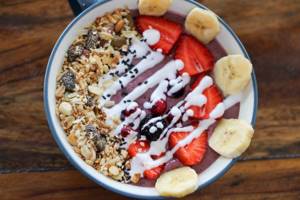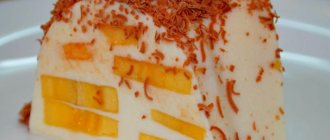Features of the methods
The name of the program is “Beautiful Habits. Beautiful body”, the marathon is divided into several stages; there are no strict restrictions on nutrition during the marathon. Elena Kalen is a psychologist, nutritional support and healthy lifestyle consultant.
She believes that for long-term and qualitative changes it is necessary to understand why we want a certain product, what consequences this choice will have on appearance, self-feeling and health.
The key difference between a marathon and other weight loss systems is working with beliefs, analyzing habits, identifying harmful ones and gradually replacing them with useful ones.
Fast and slow carbohydrates
The term “glycemic index” has entered the medical lexicon since 1981. Research has shown that the slow process has advantages:
- allows you to stay full longer;
- creates conditions for better digestion of food;
- accumulates vital energy.
For any activity, mental or physical, people need energy. The easiest way for the body to extract it is from carbohydrates supplied with food. To obtain guidelines for assessing the speed of assimilation, we calculated a scale from zero to one hundred. This indicator is called the glycemic index - GI.
Carbohydrates with a GI of more than 70 are considered fast. Carbohydrates with a GI of less than 40 are considered slow. As an analysis of metabolic characteristics has shown, they are all important for health, but their roles differ. To properly organize your diet, you need to know which foods contain slow carbohydrates and increase their amount in your diet.
Basic principles
The program is based on the following principles:
- daily water consumption of 2 liters;
- giving up alcohol and coffee;
- replacing side dishes with vegetable dishes, fatty meat with a lean version;
- excluding frying with oil, food can be boiled, baked and steamed;
- fractional meals without overeating, each meal should correspond to the designated time, and the portion size should be small.
The essence of the marathon is to learn to recognize the signals of your body.
The main principle of the Elena Kalen method: a beautiful body is the result of the right habits
Stages of the Elena Kalen Marathon
The marathon program is divided into 3 parts.
At the first stage, a correction of thinking occurs - the formation of the right attitude towards oneself, identifying the reasons for the appearance of excess weight. During this stage, participants learn to set goals and cope with stress without eating.
The second stage is changing eating habits, participants learn how to properly prepare a diet. It is compiled taking into account your favorite dishes and products.
The third stage is a combination of nutrition and training. Regular exercise is one of the healthy habits that participants need to get used to.
Benefits and harms
Fast carbohydrates, otherwise called simple carbohydrates, are great for helping you get full quickly. The most famous representative of this group is sweets, which cause a surge of energy and a sharp increase in glucose levels. At the moment when it is necessary to make an effort, for example, to solve a complex problem, they provide excellent support. But then the energy quickly runs out, and unspent glucose is stored in fat cells.
Slow carbohydrates are also called complex carbohydrates. When digested, they gradually release energy and thanks to this, the feeling of fullness lasts longer. Calorie consumption occurs gradually, without jumps, and does not cause increased fat deposition. Blood glucose levels do not change significantly.
Due to sudden jumps in glucose, sweet lovers risk disrupting normal metabolism. The body will accumulate excess weight and will not be able to resist some diseases associated with endocrine disorders. The risk group includes sweets, baked goods, chips, and soda. It is worth adding healthy cereals, vegetables, nuts, and berries to your diet.
Recommendations: You cannot completely exclude carbohydrates from your diet. They are necessary for normal metabolism. However, it is worth focusing on low GI foods, which are digested more slowly. Energy is released gradually, calories are consumed more fully, and there is nothing to be deposited in fat deposits.
How to determine GI
You won’t be able to guess what the glycemic index of foods is on your own. Since this concept came into use, special tables have been calculated. Keep a list of slow-carb foods at home and easily adjust your diet.
If you are concerned about excess weight or exercise does not bring the desired effect, analyze the food in the refrigerator. It is necessary to reduce the consumption of fast ones and pay attention to slow ones. This will help:
- lose weight;
- optimize training;
- improve your well-being.
Slow carbohydrates normalize the speed of metabolic processes, but fast carbohydrates should not be completely abandoned.
Good Habits
Elena Kalen advises sticking to the right eating habits.
- First of all, this is drinking water - 2 liters per day. At first it will be difficult to do this, especially if the person is not used to drinking such an amount of liquid during the day. To develop a habit, it is recommended to start with 1 liter and gradually increase to the required volume.
- Replace your usual foods with low-calorie foods, which include vegetables and white fish.
- Replace fried foods with steamed dishes.
- Good habits also include eating in small portions.
Pros of the program
The technique has many positive properties:
- improvement of well-being;
- variety of nutrition throughout the training;
- no age restrictions;
- the ability to normalize body weight;
- maintaining the result for a long period;
- developing love and respect for your body;
- learning proper habits and body care.
Participation in the marathon has no restrictions on physical condition and the presence of chronic diseases. There is no need to follow strict dietary restrictions, and it is also not necessary to exercise during the marathon. The program actually has no downsides.

One of the conditions for the marathon is to drink at least 2 liters of water daily.
Composition and properties
The substances that make slow carbohydrates so beneficial are called monosaccharides. The following are especially important for human health:
- Glycogen, which serves as a building material for glucose. The liver is responsible for its transformation. The process occurs continuously because we expend energy even while we sleep. If the body does not receive glycogen from food, it will extract it from fat reserves (this is good) and protein reserves (that is, muscles).
- Fiber that normalizes the functioning of the intestinal tract. Steadily functioning peristalsis ensures the removal of waste products and undigested food debris from the body. If this process is disrupted, not only gastrointestinal diseases develop, but also metabolic disorders and a slowdown in metabolism.
- Starch is responsible for the production of enzymes necessary for the gradual absorption of glucose by the body. With a lack of these substances, surges in blood sugar occur, which can ultimately lead to the development of chronic endocrine diseases.
- Insulin is a hormone that is produced in the pancreas and is responsible for tissue metabolism. The level of glucose in the blood depends on it. Its deficiency leads to diabetes. A hundred years ago, this disease was considered incurable.
In addition, foods with a low glycemic index contain other beneficial substances - vitamins and microelements.
Conclusion: slow carbohydrates participate in metabolic processes in the body, ensure the maintenance of stable blood sugar levels, and normalize peristalsis. A diet rich in low-GI foods helps keep you feeling full for a long time and maintains energy. At the same time, the weight remains unchanged.
Menu for the week
To achieve a positive result, you can use a sample menu for the week.
Monday
- Breakfast - boiled egg
- Snack - pear
- Lunch - turkey cutlets and stewed cabbage
- Afternoon snack - carrot salad
- Dinner - vegetable casserole
Tuesday
- Breakfast - omelet
- Snack - a handful of berries
- Lunch - fish with rice and herbs
- Afternoon snack - a glass of kefir
- Dinner - strawberries with cottage cheese
Wednesday
- Breakfast - cottage cheese with berries
- Snack - kiwi
- Lunch - vegetable broth and fish with rice
- Afternoon snack - yogurt
- Dinner – chicken breast with broccoli
Thursday
- Breakfast - oatmeal
- Snack – green tea and a piece of cheese
- Lunch - buckwheat with chicken and vegetable broth
- Afternoon snack - cottage cheese casserole
- Dinner - tomato and cucumber salad
Friday
- Breakfast - rice porridge
- Snack - orange
- Lunch - fish with broccoli and lettuce
- Afternoon snack - fruit juice and a handful of berries
- Dinner - natural yogurt and apple
Saturday
- Breakfast - fruit salad
- Snack - apple
- Lunch - soup with chicken and vegetable stew and turkey breast
- Afternoon snack - cabbage salad
- Dinner - omelet with vegetables
Sunday
- Breakfast - cottage cheese casserole
- Snack - peach
- Lunch – zucchini puree and chicken breast
- Afternoon snack - kefir
- Dinner - stewed fish with cabbage
For variety, you can add berries, vegetables and fruits to the menu. Meat and fish can be alternated. Milk must be excluded from the diet, but fermented baked milk, kefir, cottage cheese and yogurt are allowed during the marathon.
Salts and sugars should be used in minimal quantities when preparing dishes. If you want to have a snack, you should choose fruits or vegetable salads. It is allowed to drink freshly squeezed fruit juices and dried fruit compotes.

Smoothie bowl is an excellent option for a hearty and balanced breakfast.
Table of products by GI level
Do you want to normalize your weight? Review your diet, increase the amount of slow carbohydrates by reducing fast ones. The initial stage can be difficult, since guessing the glycemic index of foods is not easy. A food table will help you create a healthy diet.
| Products | GI |
| Crustaceans (lobster, crab, lobster) | 5 |
| Spices (basil, oregano, cumin, cinnamon, vanilla, etc.) | 5 |
| Vinegar | 5 |
| Avocado | 10 |
| Peanut | 15 |
| Soybeans | 15 |
| Green peas | 15 |
| Mushrooms | 15 |
| Cereal germ | 15 |
| Ginger | 15 |
| Zucchini | 15 |
| White cabbage | 15 |
| Broccoli | 15 |
| Brussels sprouts | 15 |
| Sauerkraut | 15 |
| Cauliflower | 15 |
| Gherkin | 15 |
| Onion | 15 |
| Leek | 15 |
| Shallot | 15 |
| Lupine | 15 |
| Almond | 15 |
| Cucumber (ripe, fresh vegetables) | 15 |
| Pickled cucumbers | 15 |
| Olives | 15 |
| Walnut | 15 |
| Hazelnut (hazelnut) | 15 |
| Pine nuts | 15 |
| Cashew nuts | 15 |
| Bran (wheat, oat) | 15 |
| Sweet pepper | 15 |
| Chili pepper, capsicum | 15 |
| Pesto (sauce) | 15 |
| Sprouted grains (wheat, soy, etc.) | 15 |
| Rhubarb | 15 |
| Radish | 15 |
| Carob powder (thickener) | 15 |
| Iceberg lettuce (leaf, arugula and other products) | 15 |
| Beetroot | 15 |
| Celery (stems) | 15 |
| Agave syrup | 15 |
| Black currant (fresh berries) | 15 |
| Asparagus | 15 |
| Tempeh (from fermented soybeans) | 15 |
| Tofu (bean curd) | 15 |
| Green beans | 15 |
| Fennel | 15 |
| Physalis | 15 |
| Pistachios | 15 |
| Zucchini | 15 |
| Spinach | 15 |
| Sorrel | 15 |
| Endive | 15 |
| Artichoke | 20 |
| Acerola (Barbados cherry) | 20 |
| Eggplant | 20 |
| Bamboo shoots | 20 |
| Sugar free jam (Montignac) | 20 |
| Soy yogurt (natural) | 20 |
| Cocoa powder (sugar-free product) | 20 |
| Lemon (fresh or ripe fruit) | 20 |
| Palm pulp | 20 |
| Ratatouille | 20 |
| Soy products | 20 |
| Soy cream | 20 |
| Soy sauce (sugar-free product) | 20 |
| Lemon juice (sugar-free product) | 20 |
| Fructose (from sugar beet, European) | 20 |
| Dark chocolate (85% cocoa) | 20 |
| Soybeans, canned | 22 |
| Peanut butter (sugar-free product) | 25 |
| Cherry (fresh berries) | 25 |
| Blueberries (fresh berries) | 25 |
| Dry peas | 25 |
| Blackberries (fresh berries) | 25 |
| Strawberry (fresh berry) | 25 |
| Barley groats | 25 |
| Gooseberry | 25 |
| Raspberry (fresh berry) | 25 |
| Cloudberry (fresh berry) | 25 |
| Soy flour | 25 |
| Hazelnut butter (sugar-free product) | 25 |
| Unshelled almond paste (sugar-free product) | 25 |
| Red currant (fresh berries) | 25 |
| Pumpkin seeds | 25 |
| Mungo beans | 25 |
| Flajole beans | 25 |
| Hummus | 25 |
| Blueberries (fresh berries) | 25 |
| Green lentils | 25 |
| Dark chocolate (70% cocoa) | 25 |
| Apricot (fresh) | 30 |
| Vermicelli soy | 30 |
| Grapefruit and pomelo (fresh or ripe fruit) | 30 |
| Pear (fresh or ripe fruit) | 30 |
| Jam (no sugar, with fruit juice) | 30 |
| Mandarin, clementine | 30 |
| passion fruit | 30 |
| Marmalade (no sugar) | 30 |
| Almond milk | 30 |
| Oat milk (raw) | 30 |
| Soy milk | 30 |
| Powdered milk** | 30 |
| Milk** (any fat content) | 30 |
| Carrots (fresh) | 30 |
| Chickpeas | 30 |
| Oat (oyster) root | 30 |
| Beetroot (fresh) | 30 |
| Scorzonera (goat) | 30 |
| Rennet cheese** | 30 |
| Cottage cheese** not pressed | 30 |
| Tomatoes | 30 |
| Turnips, turnips (fresh) | 30 |
| Green beans | 30 |
| Garlic | 30 |
| Yellow lentils | 30 |
| Brown lentils | 30 |
| Chocolate milk | 34 |
| Whole grain bread “Montignac” | 34 |
| Quince (fresh or ripe fruit) | 35 |
| Amaranth (seeds) | 35 |
| Anona (carom, “starfruit”) | 35 |
| Orange (fresh or ripe fruit) | 35 |
| Durum wheat vermicelli | 35 |
| Green peas (fresh) | 35 |
| Mustard, Dijon | 35 |
| Pomegranate (fresh or ripe fruit) | 35 |
| Baker's yeast | 35 |
| Brewer's yeast | 35 |
| Figs (fresh or ripe fruit) | 35 |
| Natural yogurt** | 35 |
| Soy yogurt (flavored) | 35 |
| Cassoulet | 35 |
| Quinoa | 35 |
| Indian corn | 35 |
| Fresh corn | 35 |
| Sesame seed | 35 |
| Dried apricots | 35 |
| Flax-seed | 35 |
| Maize | 35 |
| poppy seed | 35 |
| Almond butter (sugar-free product) | 35 |
| Soy milk ice cream | 35 |
| Creamy ice cream (fructose) | 35 |
| Chickpea flour | 35 |
| Nectarine (fresh or ripe fruit) | 35 |
| Chickpeas (canned) | 35 |
| Prickly pear (fresh or ripe fruit) | 35 |
| Peeled almond paste (sugar-free product) | 35 |
| Peach (fresh or ripe fruit) | 35 |
| Sunflower (sunflower seeds) | 35 |
| Wild rice | 35 |
| Celery root (raw) | 35 |
| Plums (fresh or ripe fruit) | 35 |
| Tomato juice | 35 |
| Tomato juice | 35 |
| Tomato sauce (sugar-free product) | 35 |
| Dried tomatoes | 35 |
| Falafel (chickpea) | 35 |
| Adzuki beans | 35 |
| White beans | 35 |
| Borpotti beans | 35 |
| Red beans | 35 |
| Black beans | 35 |
| Sprouted grain bread | 35 |
| Wasa crispbread with fiber (24%) | 35 |
| Chocolate bars (sugar free) | 35 |
| Dried apples | 35 |
| Apple (fresh or ripe fruit) | 35 |
| Baked apple | 35 |
| Applesauce | 35 |
| Applesauce (sugar-free product) | 35 |
| Lima bean soup | 36 |
| Peanut butter (sugar-free spread) | 40 |
| Beans, fava (raw) | 40 |
| Pear melon | 40 |
| Quince jelly (sugar-free product) | 40 |
| Dried figs | 40 |
| Whole grain kamut | 40 |
| Buckwheat porridge | 40 |
| Buckwheat | 40 |
| Sesame paste, tahini | 40 |
| Lactose | 40 |
| Matzo (whole wheat flour) | 40 |
| Coconut milk | 40 |
| Quince flour | 40 |
| Buckwheat flour | 40 |
| Quinoa flour | 40 |
| Oats | 40 |
| Oat flakes (unprocessed) | 40 |
| Whole wheat pasta cooked al dente | 40 |
| Shortbread cookies (whole grain flour, no sugar) | 40 |
| Spelled | 40 |
| Dry cider | 40 |
| Carrot juice (sugar-free product) | 40 |
| Sorbet (sugar-free product) | 40 |
| Spaghetti cooked in 5 minutes | 40 |
| Takhin | 40 |
| Falafel (from beans, fava) | 40 |
| Red beans (canned) | 40 |
| Whole grain flour bread (100%) yeast | 40 |
| Pumpkin bread | 40 |
| Chicory (drink) | 40 |
| Prunes | 40 |
| Lentil soup | 44 |
| Pineapple (fresh or ripe fruit) | 45 |
| Orange juice (sugar-free product) | 45 |
| Dessert banana (green) | 45 |
| Plantain banana (raw) | 45 |
| Whole grain bulgur (finished product) | 45 |
| Grapes (fresh berries) | 45 |
| Green peas (canned) | 45 |
| Jam (no sugar, with grape juice) | 45 |
| Whole grain cereals (sugar-free product) | 45 |
| Capellini (a type of pasta, thinner than spaghetti) | 45 |
| Cranberry (fresh berry) | 45 |
| Coconut | 45 |
| Whole grain couscous, whole grain semolina | 45 |
| Kamut flour (whole wheat) | 45 |
| Spelled flour (whole grain) | 45 |
| Whole grain rye flour | 45 |
| Muesli “Montignac” | 45 |
| Spelled (whole grain) | 45 |
| Basmati rice, unpeeled | 45 |
| Grapefruit juice (sugar-free product) | 45 |
| Tomato sauce (with added sugar) | 45 |
| Whole grain toast | 45 |
| Grilled bread, made from whole grain flour, without sugar | 45 |
| Kamut bread | 45 |
| Pumpernickel bread “Montignac” | 45 |
| Whole grain rye bread | 45 |
| Whole grain bread (made from whole grain flour) | 45 |
| Fruit bread | 47 |
See the full table of the glycemic index of foods* Products with a carbohydrate content of less than 5%, so their glycemic load index is low and can be consumed in moderation without risk.** Dairy products, since despite their low glycemic index they have a high insulin index index, so they must be used with caution.
When creating a menu, consider the lifestyle you lead. You don't have to completely give up fast carbohydrates. They will be useful for recuperating after intense physical training and during active mental activity (during exams). If you give up sweets, a loss of strength is guaranteed. High GI foods will help you recover quickly.
If you have a sedentary lifestyle, focus on low GI foods. If you are planning to lose weight, consult your doctor or nutritionist to choose the right diet.
There is a list of foods with a large amount of fast carbohydrates, but there is no need to completely exclude them from the diet, because even among the protein components (in the form of a sports supplement) there is a small amount of carbohydrates. So, here is a list of foods high in fast carbohydrates:
- vegetables with a large starch component;
- sugar;
- flour products (this does not include brown bread);
- drinks with a lot of sugar.
In details:
- potato dishes (frying, boiling, frying, stewing);
- soups that do not require long cooking;
- fruit juices, soda and still drinks with a lot of sugar;
- fruits with a sweet taste (bananas, watermelons, grapes);
- honey;
- various vegetables (corn kernels, turnips, celery (root), carrots);
- cookies and other baked goods (sweet rolls, bread made from white or gray flour, bagels, rice biscuits, biscuits, donuts);
- syrups.
By the way, the glycemic index of these food options is at least 69 units. This is a significant level that affects the amount of sugar (glucose) in the blood.
Slow carbohydrates have a lower glycemic index, which does not have as much effect on the amount of glucose in the blood. However, we must not forget that foods that contain fast carbohydrates have different characteristics. For example, fried potatoes have an index of 95 units, but bread made from white flour has only 70 units.
| Product | Glycemic index |
| Potato | 80-95 |
| Fruits | 63-100 |
| Honey | 89 |
| Drinks, juices | 65-75 |
| Flour products | 65-95 |
| Sweets (waffles, cookies) | 75-80 |
| Vegetables | 65-100 |
| Food that doesn't require long cooking | 66-93 |
This information allows you to navigate when choosing the right food. You just need to keep in mind that when choosing a product available in this table, you should take into account its glycemic index, it will be in the presented range of numbers.
It is recommended to consume less fast carbohydrates, and use them only when necessary (at the end of the training process). Otherwise, foods with a large number of fast carbohydrates will contribute to the appearance of excess body weight.
There are special lists and tables of options for foods with slow carbohydrates that help reduce body weight (they have a low glycemic index).
Here is the detailed list:
- Dill, basil, lettuce.
- All legumes, including soybeans.
- Cereal porridge. Oatmeal, pearl barley, and millet are preferred. Semolina has a high glycemic index, so it is better not to consume it.
- Pasta made from durum wheat.
- Low grade bread.
- Fruits containing little fructose (kiwi, apple, cherry, tangerine). You need to know that dried fruits have a higher (usually 10-15 units) glycemic index compared to their fresh counterparts. And this level also becomes higher during heat treatment. Therefore, it is better to eat fruits as usual. Fruit juices, and freshly squeezed ones too (even if you don’t add sugar), due to the lack of fiber, have an index close to the upper limit.
- Berries (plum, cherry, cranberry).
- Natural yogurt without fillers.
- Mushrooms.
- Nuts, chocolate (the amount of cocoa beans in it should exceed 75%), sunflower seeds. These foods are considered high-calorie, but are broken down by the body rather slowly.
- Vegetables (onions, cabbage, leeks, zucchini, tomatoes, spinach, bay leaves, peppers).
- Papaya, sweet potato (yam), mango, corn, persimmon. These products have the highest glycemic indices among all slow carbohydrates. Therefore, they must be used very carefully.











